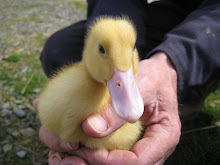 I was at a conference this week, in the role of report writer, listening to some of the most extraordinary people working in performing arts training in the world today. Everywhere my ears settled there was wisdom, passion, and talent beyond measure. It is to these people that we owe our most loved theatre, films, television programmes, radio plays, ballet, contemporary dance, human circus skills and more. These are the people who train the most outstanding talent, who bring the skill, technique and understanding that shapes our cultural world. I won't even start to share what they have to say about The X Factor and similar instant fame nonsense.
I was at a conference this week, in the role of report writer, listening to some of the most extraordinary people working in performing arts training in the world today. Everywhere my ears settled there was wisdom, passion, and talent beyond measure. It is to these people that we owe our most loved theatre, films, television programmes, radio plays, ballet, contemporary dance, human circus skills and more. These are the people who train the most outstanding talent, who bring the skill, technique and understanding that shapes our cultural world. I won't even start to share what they have to say about The X Factor and similar instant fame nonsense.There was some reflection on the brilliant A History of the World in 100 objects and that made me think about my personal precious things. No doubt because I was so heavily immersed in things theatrical that day, the first thing that came to mind was my copy of Antony Sher's Year of the King.
As an Eng Lit graduate I was familiar with and in awe of Shakespeare (of course), but not particularly enamoured. I craved new writing, contemporary work, novelty. What did I know? And then I went to see Antony Sher in Richard III and stumbled out of the theatre exhausted and mesmerised. Although I had seen a lot of theatre, there were only a very few performances that stunned me (Warren Mitchell at the National in Death of a Salesman was one of these). I didn't know that Shakespeare could be like that. I didn't know that ACTING could be like that. The performance swung round and round in my mind for months. Then Sher wrote a book about the experience and I devoured every word, reliving that night again and again.
Shortly after, I started working at the Royal Shakespeare Theatre in Stratford upon Avon, feeding the actors, the stage crew, the wardrobe department, the musicians, the staff, and there was Antony Sher, now playing Shylock in the Merchant of Venice. His dresser, the terrifying Black Mac, saw me with my copy of the book and asked me if I'd like Antony to sign it. Oh yes please!
A few days later Black Mac, also known as Black Mac the Bastard, and vividly sketched in the book complete with Mike TV glasses, handed it back, sort of nonchalantly. The frontispiece was signed "To Debbie, with thanks and fondest wishes, Antony Sher, Stratford 25/6/87". Precious indeed, but that wasn't all. Black Mac had gone to every member of staff and cast who had been recorded in the book either by name or by sketch (often both) and who were in Stratford for the current season. As I flicked through I realised I held in my hand a theatrical gem: Brian Cox, Bill Alexander, John Carlisle, Black Mac the Bastard himself, and more.
Sometimes you feel entirely in the moment, of the moment. Seeing the play, reading the book and then having my book returned to me so joyfully enhanced were three of those times.
As light hearted contrast, I offer my micro anecdote of cooking for Vanessa Redgrave. My hopelessly inadequate "Vanessa, your cauliflower cheese is ready", haunts me still.

































